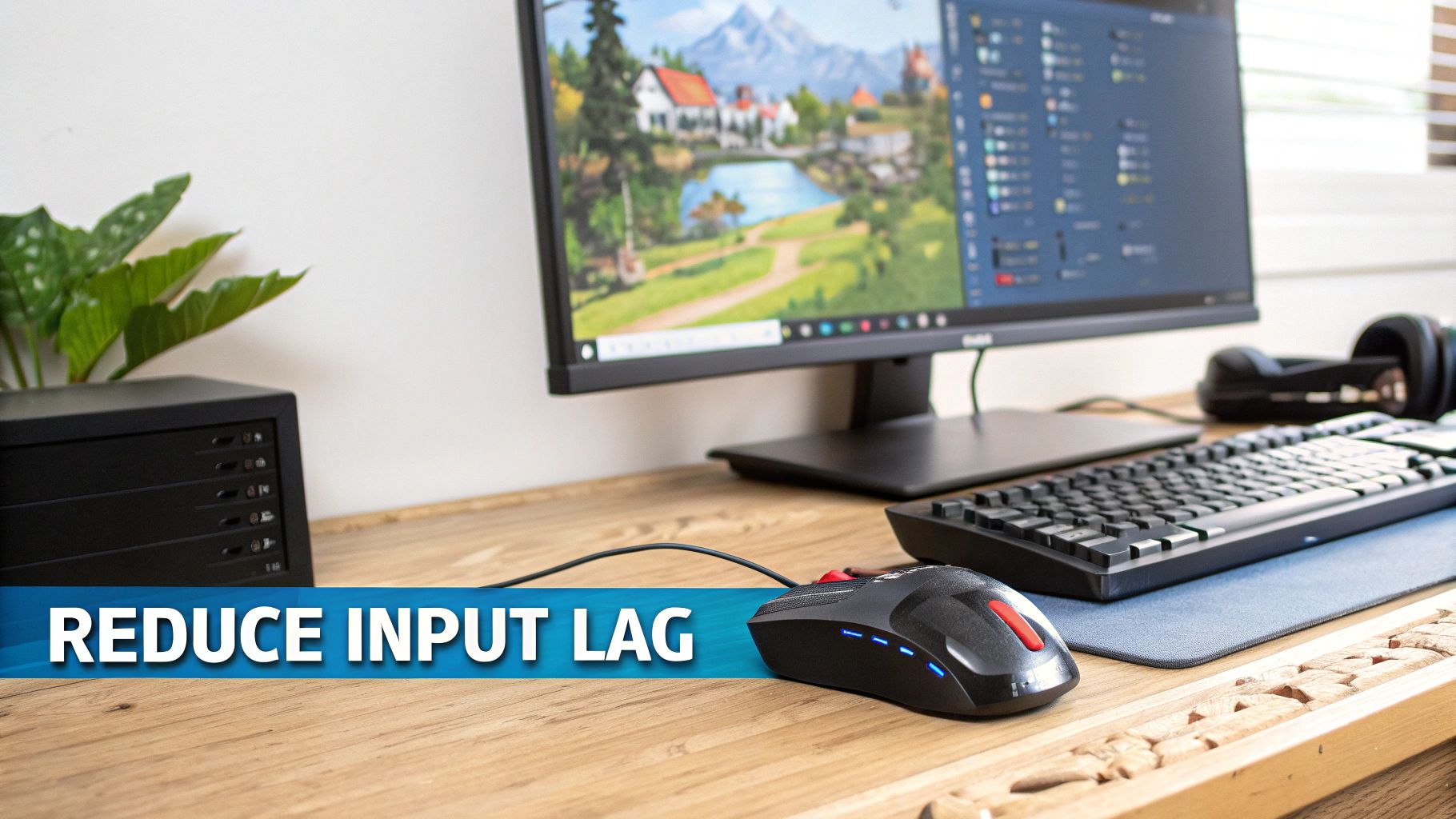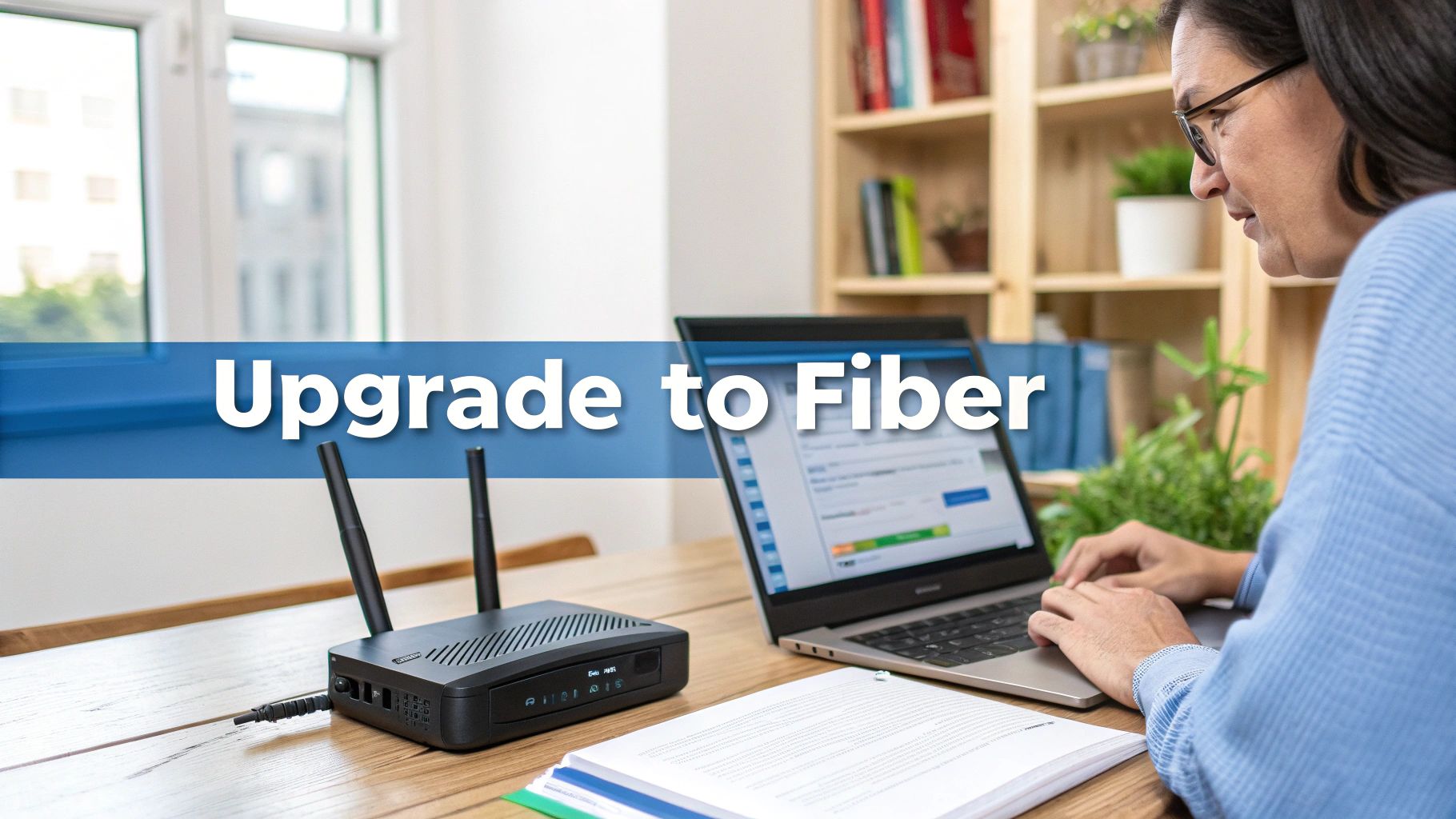When that critical moment hits—the perfect shot, the final boss—the last thing you want is a sudden freeze. Every gamer knows the soul-crushing frustration of lag. It's the ghost in the machine that snatches victory right from your grasp.
But what is this invisible enemy, really? It's more than just "slow internet." It's a triple-threat of issues working against you:
- Latency (Ping): This is the round-trip time for your command (like firing a weapon) to reach the game server and return. High ping means a frustrating delay between what you do and what you see.
- Jitter: Think of this as inconsistent ping. It causes that awful, unpredictable stuttering that makes aiming impossible and gameplay feel unreliable.
- Packet Loss: This happens when pieces of game data get lost on their way to or from the server. It can lead to bizarre glitches or your actions simply not registering at all.
This guide is your first-aid kit. We're starting with the foundational, high-impact fixes you can do right now for immediate relief.
Ditch Wi-Fi for a Wired Connection
Let's get straight to the point: the single most effective thing you can do to crush lag is to plug in an Ethernet cable. A wired connection is simply faster, more stable, and far less prone to the interference that plagues Wi-Fi.
Competitive gamers running wired setups often see latencies in the 20 to 39 millisecond range. Meanwhile, many gamers on Wi-Fi are stuck with 40ms to over 60ms. That difference is huge when every millisecond counts. You can learn more about the impact of latency on platforms like PubNub.
A wired connection is non-negotiable for serious gaming. It virtually eliminates Wi-Fi-related jitter and packet loss, providing the most reliable link to the game server.
Shut Down Background Bandwidth Hogs
Your game isn't the only thing demanding a piece of your internet connection. Video streams, cloud backups, and sneaky software updates running in the background can devour your bandwidth, causing lag spikes at the worst possible moments.
Before you launch your game, do a quick sweep. Open your Task Manager on PC or check for active downloads on your console and close everything you don't need. The usual suspects include:
- Streaming services like Netflix or YouTube
- Large file downloads or torrent clients
- Cloud-syncing apps like Dropbox and OneDrive
- Automatic game and system updates
The Simple Power of a Restart
Never underestimate a good old-fashioned "power cycle." Restarting your router, modem, and gaming device is like giving your gear a fresh start. It clears out temporary memory, fixes minor software glitches, and re-establishes a clean connection to your internet provider.
It's a surprisingly effective fix for a wide range of connection issues. For a deeper look into your network's health, you might be interested in our guide on network diagnostic utilities. This quick reset ensures all your hardware is starting from a clean slate, ready for action.
Before we dive deeper, here's a quick summary of these initial steps and how they help.
| Quick Fixes and Their Impact on Lag |
|---|
| Action |
| Use a Wired Ethernet Connection |
| Close Background Apps & Downloads |
| Restart Router, Modem, & Gaming Device |
These foundational fixes create a stable baseline for your connection. With these out of the way, you're in a much better position to tackle more advanced optimizations.
Optimizing Your Home Network for Gaming
If you've ever experienced a match-losing lag spike, you know the real battle isn't just on-screen—it's happening on your home network. Going beyond a simple modem reset is where you gain a real competitive edge. It’s time to fine-tune your router’s settings and tell your network that gaming traffic is priority number one.
Many routers come with a feature called Quality of Service (QoS). Think of it as a traffic manager for your internet. It lets you prioritize specific devices (like your PC or console) or types of traffic, making sure your game gets the bandwidth it needs, even if someone else fires up a 4K Netflix stream in the living room.
Activating QoS can be a game-changer for reducing those frustrating lag spikes caused by a busy network. Just log in to your router’s admin page, find the QoS settings, and put your gaming device at the very top of the priority list.
Master Your Wi-Fi Environment
Even if you’re plugged in with an Ethernet cable, a crowded Wi-Fi environment can still cause interference that hurts your entire network. All your neighbors' Wi-Fi networks are fighting for the same limited airwaves, which can easily lead to packet loss and jitter.
Most routers pick a Wi-Fi channel on their own, but it's rarely the best one. You can use a Wi-Fi analyzer app on your phone to see which channels are the most congested in your area. From there, log into your router and manually switch to a clearer channel. This one small tweak can make a massive difference.
Key Takeaway: Don't let your router run on autopilot. Taking control of settings like QoS and Wi-Fi channels gives you the power to stamp out network-related lag.
If you are stuck on a wireless connection, keep in mind how much the technology has improved. You can learn more about how the latest standards perform better in crowded spaces in our guide to Wi-Fi 5 vs Wi-Fi 6 technology.
The infographic below highlights a simple, three-step process for tackling the most common culprits behind gaming lag.

This visual guide is a great reminder that the best first steps are always to secure your connection, close unnecessary programs, and give your hardware a quick reboot.
Advanced Router Features for Gamers
Beyond just changing channels, today’s routers have powerful features designed for stronger, more stable connections. First, always keep your router's firmware updated. These updates often bring performance boosts and security fixes that directly impact stability. If you're constantly battling wireless issues, it's also worth taking steps to improve your WiFi signal throughout your home.
Also, dig into your router's settings and look for these features:
- MU-MIMO (Multi-User, Multiple Input, Multiple Output): This lets your router talk to multiple devices at the same time instead of making them wait in line. In a house full of connected gadgets, this is essential.
- Beamforming: Instead of just blasting the Wi-Fi signal out in every direction, beamforming technology focuses it directly at your gaming device, creating a much stronger and more reliable connection.
Turning on these features can transform your standard home network into a finely tuned machine built for low-latency gaming. When every millisecond is the difference between winning and losing, optimizing your network is a must.
Fine-Tuning Your Hardware and In-Game Settings

When your internet connection is solid but you’re still losing gunfights, the real culprit might be hiding in your gaming rig. This is where input lag comes into play—that frustrating delay between when you click your mouse and when your character fires on-screen. Getting your hardware and software settings dialed in is a crucial step to making your gameplay feel snappy and instantaneous.
For PC gamers, the journey always starts with your graphics card drivers. Keeping your NVIDIA, AMD, or Intel drivers up to date is non-negotiable for performance. These updates often pack in optimizations for the latest games, which can seriously boost your frame rates and cut down latency.
Don't just stop at updating, though. Dive into your graphics card’s control panel. Look for powerful features like NVIDIA Reflex, which is built specifically to slash system latency in competitive games and give you a real, measurable advantage.
Hardware Lag vs Network Lag Symptoms
It's easy to blame your internet for every stutter, but sometimes the problem is right on your desk. Knowing how to tell the difference between hardware-based input lag and network lag is key to finding the right fix. Here’s a quick breakdown of what to look for.
| Symptom | Likely Cause (Hardware) | Likely Cause (Network) |
|---|---|---|
| Choppy, stuttering screen movement | Low frames-per-second (FPS) | Packet loss or high jitter |
| Delay between mouse/keyboard action and on-screen result | High input lag, V-Sync enabled | High latency (ping) |
| Characters warping or "teleporting" | Unlikely to be a hardware issue | Severe packet loss or connection instability |
| Game feels sluggish or "heavy" | Low FPS, input lag | High but stable latency (ping) |
| Screen tearing (horizontal line breaks) | V-Sync is disabled and FPS doesn't match monitor refresh rate | Not a network issue |
Understanding these symptoms helps you focus your efforts. If your game feels sluggish but other players aren't warping around, your hardware is probably the bottleneck.
PC Gaming Graphics and Display Settings
Your in-game settings menu holds a ton of power over your experience. One of the biggest culprits for lag is V-Sync (Vertical Sync). It’s great for eliminating screen tearing, but it often does so by introducing a noticeable delay, forcing your game’s frame rate to lock to your monitor's refresh rate.
For a much more responsive feel, try turning V-Sync off. If you start seeing ugly screen tears, look for better alternatives like G-Sync (NVIDIA) or FreeSync (AMD), which sync your frame rate without adding all that extra delay. You can also get a big performance boost by lowering demanding graphics settings like shadows, textures, and anti-aliasing. A higher frame rate directly reduces the time it takes for each action to register on screen.
Even at a blistering 600 FPS, players can still feel significant input lag. This proves that a high frame rate alone isn’t the magic bullet—your entire system, from hardware to software, needs to be optimized.
Console Performance Modes and Peripheral Optimization
If you're gaming on a PlayStation 5 or Xbox Series X/S, you have a critical choice to make: Performance Mode vs. Quality Mode. Quality Mode makes everything look gorgeous with ray tracing and 4K textures, but it usually comes at the expense of your frame rate. Performance Mode flips that script, prioritizing a silky-smooth frame rate (often 60 or 120 FPS) by toning down the eye candy.
For any competitive game, you should always choose Performance Mode. The higher, more stable frame rate is your ticket to lower input lag and a much more responsive game.
Don't forget your peripherals, either. That standard office mouse you have might be locked to a low DPI (Dots Per Inch), making your aim feel sluggish and imprecise. Upgrading to a proper gaming mouse with adjustable DPI lets you dial in the perfect sensitivity for lightning-fast reactions.
Ultimately, getting the best performance is about creating a balanced system. Investing in top-tier gear, like powerful gaming laptops like the Alienware 18 Area-51, shows just what premium components can do. By making sure your hardware and software are working together, you can build a setup where every single move feels instant.
Evaluating Your Internet Plan and Provider

After you’ve optimized everything inside your four walls, it’s time to look at the source: your internet connection itself. Your Internet Service Provider (ISP) and the specific plan you pay for are the ultimate gatekeepers of your gaming performance.
Frankly, no amount of in-home tweaking can fix a fundamentally slow or unstable service coming into your house. Providers love to market blazing-fast download speeds, but for gaming, that's only half the story. The technology delivering that speed is what truly matters for squashing lag.
Why Fiber Is the Gold Standard for Gaming
The type of internet you have makes a night-and-day difference. Fiber optic internet is the undisputed champion for gamers, hands down. It delivers incredibly low latency and symmetrical speeds, meaning your upload speed is just as fast as your download speed.
Let's break down how different connection types really stack up for gaming:
- Fiber Optic: This is the best you can get. Data literally travels at the speed of light over glass strands, giving you the lowest possible ping and rock-solid stability.
- Cable: A decent, widely available choice. The main drawback is that it uses shared connections in neighborhoods. Your speeds can tank during peak hours when everyone jumps online.
- DSL: This is older tech that runs over phone lines. It’s almost always slower and less reliable than cable or fiber, making it a frustrating choice for any serious gamer.
- 5G/LTE Home Internet: While the tech is promising, this kind of wireless home internet is often prone to higher latency and instability from signal interference, making it less than ideal for competitive play.
If you have the option, switching to a fiber connection is one of the single most impactful upgrades you can make to your entire gaming setup.
Your internet plan's fine print matters. A fiber plan with a lower advertised speed will almost always outperform a cable plan with a higher speed for gaming due to its superior latency and stability.
The Importance of Upload Speed
Download speed gets all the glory, but your upload speed (or egress bandwidth) is absolutely critical for a smooth gaming experience. Every single action you take—moving your character, firing a weapon, casting a spell—is data you are uploading to the game server.
A slow or unstable upload connection is what causes your actions to feel delayed or, even worse, not register at all. This is especially true if you stream on platforms like Twitch. A weak upload speed will choke trying to handle both game data and a high-quality video stream, causing lag for you and your viewers.
If you need a service that can easily handle both, check out our guide on finding the best internet for streaming and gaming.
Ditching the ISP-Provided Router
That router your ISP gave you? While convenient, it's almost always a basic, budget model designed to be "good enough" for browsing Facebook, not for high-performance gaming.
These routers often lack advanced features like robust QoS and MU-MIMO. More importantly, they lack the raw processing power to handle heavy network traffic without slowing to a crawl. Investing in your own high-quality gaming router puts you in complete control, allowing you to prioritize gaming traffic and ensure your hardware isn't the bottleneck holding back your premium internet plan.
What’s Next in the Fight Against Gaming Lag?
While tweaking your own setup is a huge part of the battle, the long-term fix for lag involves some pretty massive shifts in how the internet itself works. The future isn't just about getting faster internet at home; it's about building a smarter, more spread-out network designed for the split-second response times that serious gaming demands.
Leading this charge is a concept called edge computing. Right now, the game server you're connecting to could be hundreds of miles away, which means your data has a long trip to make. Edge computing flips that script by moving the heavy lifting—the processing power and game logic—to smaller data centers that are physically much closer to you.
This is an absolute game-changer for cutting down those frustrating latency spikes. By 2025, you can expect to see more gaming platforms roll out this kind of edge infrastructure, drastically shortening that round-trip data time and making every action feel instant. Spirent has a great breakdown of how edge computing is poised to eliminate lag if you want to dive deeper.
The Cloud Gaming Frontier
Platforms like GeForce Now and Xbox Cloud Gaming are another piece of the puzzle. These services stream entire games to your screen, which creates its own unique latency headache. Every single button you press has to travel to a server far away, get processed, and then the video of what happened has to be streamed back to you in a flash.
To make this work, providers are getting seriously creative:
- Predictive AI: Imagine algorithms smart enough to guess your next move and start rendering the frame before you even make it. It's happening.
- Dedicated Fiber Backbones: Companies are building their own private, high-speed networks to shuttle data between their data centers, cutting down on transit time.
- Smarter Video Encoding: New compression methods are shrinking the size of video streams without wrecking the visual quality, which means they get to you faster.
This diagram shows just how much closer edge computing brings the game server to the player.
You can see how it dramatically cuts down the distance your data has to travel. That’s the core advantage of edge computing for a truly low-latency experience.
The End Goal: Ultimately, the mission for cloud gaming is to make it feel exactly like you're playing on a high-end PC or console right in your room. That means getting the total "click-to-pixel" time so low that our eyes and brains can't even perceive a delay.
Smarter Networks That Think Ahead
Beyond just moving servers closer, the networks of the future will use AI to manage traffic way more effectively. Think of a network that can predict a traffic jam before it even starts and automatically re-route your game data along the fastest, most stable path available at that exact moment.
This idea, known as AI-driven predictive routing, is set to tackle the jitter and packet loss that can ruin a match even on a fast connection.
All these developments are pointing to a future where a smooth, low-latency gaming experience isn't just for people with the absolute best internet plans. It'll be the standard. The war on lag is being fought on multiple fronts, and the tech on the horizon looks incredibly promising.
Frequently Asked Questions About Gaming Lag
Even after tweaking every possible setting, a few nagging questions about gaming lag always seem to surface. Let's walk through some of the most common ones and get you the clear answers you need to finally smooth out your gameplay.
A big one we hear all the time is about using a VPN. A Virtual Private Network (VPN) is mostly for security, but can it actually help your connection? Sometimes, yes. If your Internet Service Provider is throttling your gaming traffic or sending your data on a scenic tour across the country, a good VPN can find a more direct route to the game's servers.
But it's not a universal fix. Adding another stop for your data can just as easily add a few milliseconds to your ping. The best way to know for sure is to try a trusted VPN that offers a free trial. See for yourself if it makes a real difference for your connection and the games you play.
What Is a Good Ping for Gaming?
What counts as a "good" ping really comes down to what you're playing. For a slower-paced strategy game or a massive online RPG, you can get away with a higher number. But for fast-action shooters or fighting games where a split-second is the difference between winning and losing, you need that number to be as low as possible.
Here’s a quick breakdown of what to aim for:
- Excellent (Under 20ms): This is pro-level, competitive gaming territory. Your actions will feel completely instant.
- Great (20-50ms): For most serious gamers, this is the sweet spot. You'll get incredibly smooth and responsive gameplay without any noticeable delay.
- Acceptable (50-100ms): Perfectly fine for most casual games. In high-stakes competitive matches, though, you might start to feel a slight disadvantage.
- Poor (Over 100ms): At this point, you're going to feel significant lag. It becomes tough to compete when your character is always a step behind.
Key Takeaway: For the best possible online gaming experience, always try to keep your ping below 50ms. It gives you a real competitive edge and makes every session more enjoyable.
Lag vs. Low FPS: What Is the Difference?
It’s one of the most common mix-ups in gaming: confusing lag with low FPS (Frames Per Second). They feel similar, but they are totally different problems with completely different fixes. Knowing which one you're dealing with is the first step to solving it.
Lag is a network issue. It’s all about your internet connection—specifically, high latency (ping), jitter, or packet loss. When other players are zipping around the map erratically or your shots just don't seem to register, that's lag.
Low FPS is a hardware issue. This happens when your PC or console just can't keep up with rendering the game's graphics. If the game feels choppy, stutters, or turns into a slideshow during intense action, your hardware is the bottleneck. It has nothing to do with your internet.
Think of it this way: lag is about how fast your commands get to the game server. FPS is about how smoothly your machine can draw the picture on your screen. You can have a perfect internet connection and still get terrible FPS if your graphics card is outdated, and the reverse is also true.
Ready to defeat lag for good? The most reliable way to ensure a low-latency connection is with a 100% fiber network. Premier Broadband delivers the symmetrical speeds and stability you need to stay competitive. Upgrade your gaming experience today.




